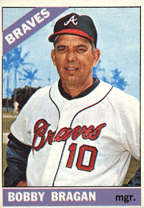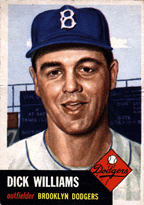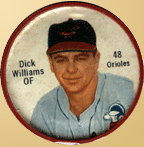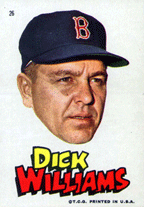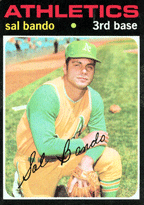|
|
|
| |

|
|
| |
|
| |

Contrary
to popular opinion, Alchemy is alive and well. How else do
you explain a man like Dick Williams?
Time and again, he found ways to turn scrap metal into gold—first
with his own playing career, and then with countless players
as the manager of the high-achieving Boston Red Sox, Oakland
A’s, Montreal Expos, San Diego Padres and Seattle Mariners.
Baseball’s
newest Hall of Fame skipper got to Cooperstown with a combination
of strength and flexibility. Dick had the fortitude to stand
up to owners and superstars, yet bent easily when it came
to building winners around the talent he had on hand. Few
managers were better when it came to righting a sinking ship.
In a JockBio originally crafted for SABR’s Biography
Project, Jeff Angus (author of Management by Baseball:
The Official Rules for Winning Management in Any Field)
looks at the life and career of baseball’s great turnaround
artist.
Richard
Hirschfeld Williams was born on May 7, 1929, in St. Louis,
Missouri. (Click
here for today's sports birthdays.)
He was the second of two children. According to his autobiography,
No More Mr. Nice Guy, his father Harvey struggled
through the Great Depression. The elder Williams was hard-headed
but willing to do whatever came his way. But when he didn't
find any work, he took it out on his boys in ways that today
would be called child abuse. He taught his sons to be determined
competitors—or suffer his wrath. At the same time, Dick
learned to be resourceful and to never try to escape accountability
for every single thing he did.
Dick and
his family lived with his maternal grandfather near Sportsman's
Park, home to both the National League Cardinals and American
League Browns. "I was a member of the Knothole Gang [the
club that gave free tickets to kids], and those tickets were
in the left field bleachers, so my favorite players were Chet
Laabs, the Browns' left fielder, and Joe Medwick, the Cards'
[left fielder]," Williams said.
When Dick
was 13-years-old, Harvey took the family to California, first
to Hollywood and then to Altadena. Dick's formal athletic
career started at Pasadena Junior College (then covering 11th
and 12th grades followed by two years of college). He just
about majored in sports, lettering in baseball, football,
basketball, track, tennis, and swimming. In handball, he didn't
just letter, he was city champ.
Dick was
first noticed by Los Angeles Dodger scout Tom Downey in 1946.
During a game hosted by a semi-pro team in El Monte, Downey
watched as the teenager went from bleacher fan to emergency
fill-in for the center fielder, who was knocked out by a fly
ball. The next year, the Dodgers signed Dick to his first
pro contract. He received a bonus of $1,200. After his 12th-grade
graduation, Dick immediately joined LA's Class C team in Santa
Barbara. He got into 79 games as an outfielder, batting .246
with an adequate .115 isolated power mark and eight stolen
bases. What he lacked in superstar numbers, he made up for
in hustle and picking fights.
The following
year, Dick attended his first pro spring training. It was
an historic event, the premiere of Branch Rickey's industrialization
experiment, Dodgertown at Vero Beach. Dodger management standardized
drills and certified standards of accomplishment for every
key fundamental that could be measured. Prospects participated
in sunrise-to-sunset repetitive drills designed to teach the
standard approaches to skills ranging from sliding into home
plate to throwing to second base with a runner in scoring
position. This fit well with Dick’s natural predisposition—he
believed there was a right way to execute every action on
the baseball field and that intensive commitment was the best
way to reach a goal. Not surprisingly, Dick started to internalize
the drills, adding them to the toolkit he would employ later
in less disciplined organizations.
Back in
Santa Barbara for the 1948 campaign, Dick chewed up Class
C pitching. In 97 games, he hit .335 with 29 doubles, 16 homers,
16 steals and 90 RBIs. The Dodgers promoted him to Double-A
Fort Worth, where he found himself overmatched. In 41 games,
Dick's batting average was just .207 with .064 isolated power
and no steals.
Perhaps
it was the adjustment to better pitching or meeting two of
the most important people in his life, but Dick put up the
best numbers of his pro career the following year and earned
All-Texas League honors. He posted a .310 average for Fort
Worth in 1949, with 109 runs, 30 doubles, 23 homers and 114
RBIs.
And the
two important connections he made? The first was Norma Mussato.
The two had a mutual milk delivery man, and he insisted that
the pair meet. Norma would become Dick's wife.
|
Dick
Williams,
Black Book Partners archives |
| |
Bobby Bragan was the second. A rookie manager, Bragan was
a Rickey disciple who went about his business transparently
to better communicate with his minor league trainees. He was
a strict enforcer of top-down discipline, which Dick loved.
"I
joined Fort Worth, and Bobby Bragan took over ten days after
I was sent down from Brooklyn. I had a bad start, but he stuck
with me, gave me every benefit he possibly could," Dick
said. He learned the Dodger Way—and learned to reign
in his aggressive tendencies, if only to avoid doing extra
running in the 100-plus degree West Texas heat.
Dick talked
more about Bragan in his autobiography: "There should
be a note under every one of my records that says, 'See Bobby
Bragan.' Because a bit of every one of my wins belongs to
him."
Bragan
was a master at mind games, which also intrigued Dick. For
example, Bragan would warm up a left-handed starter but switch
to a right-hander after the opposition had committed to a
lineup card. Bragan also worked the running game aggressively
to distract opponents from more important aspects of the game.
Dick internalized these techniques, as well.
Between
the 1949 and 1950 seasons at Fort Worth, Dick returned to
the Los Angeles area to earn money to subsidize his baseball
career. He had an unusual temp job as an extra in a low budget
movie, "The Jackie Robinson Story."
"How
low budget?" Dick recounted. "In one scene, I'm
the pitcher and Jackie's playing for Montréal in Jersey
City and he hits a homer. And the fans are booing him. Then
in the next day's scene, they were doing a shot of him rounding
second base ... and I was playing the second baseman, too."
At the
start of spring training in 1950, Dick had his heart set on
a move up
to Class-AAA Hollywood, where he would face a better brand
of ballplayer,
and be closer to home. To his dismay, he found himself reassigned
to Fort
Worth. Dick was told by Rickey that he would have a better
shot at
the majors playing every day in Texas than riding the pine
in California.
Rickey’s words were prophetic. Dick established himself
as a .300 hitter and placed himself firmly on Brooklyn’s
radar as a solid option for 1951.
Dick played
for the Almendares Alacranes (Scorpions) in the Cuban League
in the winter of 1950-51. He was the only American on the
squad. His Cuban League season ended prematurely in February—he
had to report for military training. A high-school football
injury kept him from combat duty. A baseball injury in a camp
game that same year got him a medical discharge.
Minor
leaguers returning from military service had to clear waivers
before they could report back to their teams. This reshaped
Dick's playing career. He was claimed by both the Pittsburgh
Pirates and the Cardinals. The Dodgers, determined to keep
him, had but one option under the rules: bring the young outfielder
up to the big club in Brooklyn.
When he
arrived in New York, he found he had something in common with
the other bench players. All were shunned by the starters.
The one vet who showed Dick encouragement was Robinson. They
had already met, not because of the movie, but because Robinson
was from Pasadena, too. Dick was buddies with Robinson's older
brother, Mack.
On June
10, Dick debuted in a double-header against Pittsburgh. In
the first game, Brooklyn manager Chuck Dressen sent the right-handed
rookie to pinch-hit for left-handed Gene Hermanski against
southpaw Bill Werle. Dick grounded out.
Dressen
installed Dick as his left fielder and leadoff man in the
second game. Aiming to make an impression in his first plate
appearance, he beat out a bunt for a single. Dick collected
three more hits to go 4-for-5 with a triple. Unfortunately,
that game contained the sum of his highlights for the season.
As the 26th player on a roster of 25 (Brooklyn did not have
to count the returning military veteran against their 25),
he eked out only 64 plate appearances for a team in a tight
pennant race that already had three accomplished starting
outfielders in Carl Furillo, Duke Snider and Andy Pafko.
While
Dick was riding the pine, he did get experience that would
serve him later. Dressen kept the youngster close to him on
the bench and taught him the fine Dodger tradition of bench-jockeying.
Dick was a natural at it. As Dressen's "designated smartass,"
he became so notorious around the league that he was occasionally
ejected from games for wisecracks other players made.
Dressen
taught Dick another critical managerial lesson. The rookie
watched his manager's palpable anxiety as the Dodgers' lead
vaporized—from 13 1/2 games ahead on August 10 to tied
on the next-to-last day of the season. Dick believed Dressen's
pacing, screaming and whining weakened his team's ability
to hold the lead. He decided that a skipper needed to radiate
calm confidence more than the shared worry. |
|
| |
In 1952, league rules again required Dick to be Brooklyn's
26th man, depriving him of the opportunity to play in Triple-A
where he could have built his skills. He could not be sent
down until May 29, when his ex-serviceman roster status would
expire. But as the date approached, Dick made a few fundamental
plays Dressen appreciated, including a 3-7 putout of a runner
at second base when he crept in from left field unnoticed
after a bunt. Dressen decided to keep him, and in August Dick
started in three consecutive games in St. Louis. In the third
game, he raced in to throw himself at a dying quail off the
bat of Vern Benson. Dick dove, extended his right arm and
heard a crack. It was a three-way shoulder separation that
essentially destroyed his ability to reach his highest potential.
His arm became a launcher of Texas League bloopers. Later,
when he played third base, a manager told Dick to throw the
ball to first on a bounce.
Dick felt
this career-sapping injury helped him become a good manager.
“My injury forced me to watch, to listen, to learn every
tiny detail about this game that once I could play in my sleep,"
he said. "Because if I ever wanted to play it again,
I could no longer be faster or stronger than anyone. Now I
had to be smarter."
“I
would sit on my butt in the dugout for nine innings and watch
both the game and its players like I'd never watched them
before. I studied opposing pitchers. I studied strategy. More
than anything, I studied human nature."
And through
it all, Dick evolved. He became someone who thought before
he acted, who took nothing on the field for granted, who wanted
to leave nothing on the field to chance. Slowly, painstakingly,
in a process that took 12 years, he turned into a topflight
manager.
Dick bounced
between Brooklyn and the team's minor league system until
the middle of the 1956 season, when Baltimore snatched him
off the waiver wire. The O's, a losing team building themselves
into a multi-decade behemoth and innovation factory, were
led on and off the field by Paul Richards, a management titan
and another important mentor for Dick. Richards loved having
the full-tilt competitor on the team so much that he acquired
him through trades three more times. Dick played the role
of "designated smartass" for Richards, the same
position that Dressen had taught him. He was a fundamentally
sharp and aggressive base runner (Richards liked to use him
as a leadoff hitter) with decent home-run power. Added to
that was his intensity and versatility.
On July
15, 1956, for example, Richards inserted Dick as the leadoff
batter in both ends of a double-header against the Detroit
Tigers. Playing center field and second base in the first
game and third base and first base in the second, Dick went
6-for-9 with two doubles, a home run, a walk and a stolen
base. He scored four runs and drove in two.
Dick hit
.286 for Baltimore in 1956, primarily as an outfielder. He
split 1957 between the Orioles and Indians after a trade to
Cleveland, then returned to the Orioles in 1958, dividing
his time between the outfield and third base. On August 26,
1958, Cleveland's Don Ferrarese shut out the O's for 11 innings,
but loaded the bases in the 12th. Dick came to the plate and
yelled at the little lefthander, "I'm not swinging at
a ball." Dick then folded himself into a deep crouch,
as his teammate Gene Woodling would do. Ferrarese walked him
on four pitches to force in a run, losing what he called the
best game he ever pitched. Dick added a further insult when
next facing the pitcher. Three weeks later, he batted leadoff
for the Birds against Ferrarese and eked out a walk to start
the game.
Dick played
for the Kansas City A’s in 1959 and 1960, logging his
two best seasons a major leaguer. He had 33 doubles and 16
homers in ’59 and 31 doubles and 12 home runs a year
later.
|
Dick
Williams, 1953 Topps |
| |
Richards reacquired Dick for the Orioles in 1961. The veteran's
skills were starting to erode, and he was basically a utility
man for the next two seasons. Richards snatched Dick up again
for the Houston Colt 45s after the 1962 campaign, but he was
traded to the Red Sox for Carroll Hardy before the season
started. In Boston, Dick was a bench player, getting into
140 games over the next two seasons. He batted .159 in his
final season, retiring with a lifetime mark of .260. He hit
70 homers and slugged .392 in 2,959 at-bats.
The Red
Sox were the American League's big-market team with the weakest
front office. Dick witnessed—and despised—what
he called the "country club" atmosphere in Boston.
Fathered by owner Tom Yawkey and his royal court of drinking
companions and yes-men, the organization was driven primarily
toward pleasing Yawkey rather than pursuing excellence. The
Red Sox hadn't risen above .500 for six years before Dick
arrived, a frustration they extended the two years he was
with them. Dick struggled to amp up the team's intensity from
the bench, hoping to teach them to hate losing as much as
he did. To his dismay, he believed he was associated with
"a bunch of losers."
While Dick’s playing skills were slipping at age 35,
his intensity, flexibility and passion were not. He caught
the eye of Boston's minor league director Neal Mahoney and
business manager Dick O'Connell. First, Mahoney invited Dick
to manage a rookie team in a spring intrasquad game. After
the Sox released Dick following the 1964 season, Mahoney offered
him a player/coach position with the team's Triple-A affiliate
in Seattle. When the farm team moved to Toronto during the
winter, manager Edo Vanni, a Seattle Homeboy, decided not
to move with the team. Mahoney gave Dick his first professional
managing job as skipper of the Toronto Maple Leafs.
For Dick,
it was an enlightening experience for several reasons. First,
according to Dick, he had to make the transition from bench
jockey (criticizing others' mistakes) to accountability enforcer
(judging his own). Given the years he spent with his hyper-critical
father and his own similar tendencies, Dick worked to see
that no mistake went unanalyzed or uncorrected. His relentless
pursuit of excellence was rough on his players—and even
rougher on opponents. Dick was doubly intense because he was
working within the "country club" organization that,
to him, represented the opposite approach.
With Toronto,
Dick also got to manage a lot of the young talent that would
play for him in Boston. His roster included 1965 International
League batting champ Joe Foy, 1966 IL batting champ Reggie
Smith, and catcher Russ Gibson.
Dick led
the Maple Leafs to International League championship in both
1965 and 1966, with records of 81-64 and 82-65. In those two
seasons, the Red Sox finished ninth, 40 games and 26 games
out of first place. When O'Connell became Boston's general
manager, he let manager Billy Herman go. The '66 squad had
played at about .500 after the All-Star break, a possible
indicator that with the right leadership, the team might be
ready to excel. O'Connell had the choice of two successful
minor league managers, Dick and Eddie Popowski. In September,
he settled on Popowski as a coach and Dick as his manager
for the following season. O'Connell sensibly gave the rookie
manager, at 37 the youngest in the league, the full off-season
to prepare.
Dick’s
preparation evolved from lessons learned from his principal
teachers. "I had three managers that you could call my
mentors: Dressen, Richards and Bragan," he said. "You
could put them in a room and they wouldn't agree on anything."
Dressen
was a counter-example for Dick—for all his smarts, he
was a narcissist who wasn't happy if the credit went to anyone
else. Richards was the innovator and tactician, seeking edges
small and large every minute of every day. And Bragan was
personally loyal, a straight-shooter and a transmitter of
the Rickey method. Dick picked up valuable insight from all
three. "I managed right along with them," he said.
"I learned from every manager what to do and what not
to do."
|
Dick
Williams,
1962 Salada Coin |
| |
From the first day of spring training in 1967, Dick made it
clear that there would be only one person in charge—him—and
there would be an avalanche of changes in management processes
and rules. He stripped outfielder Carl Yastrzemski of his
role as captain. All players who were single had to stay in
the team's hotel, and players had to show up on time or be
fined. With the standard practices he had learned with the
Dodger organization as a baseline, Dick stressed fundamentals.
He didn't just borrow from successful precedents; he innovated,
too. He was one of the first managers to use videotape for
studying opponents and coaching his players—though he
had to borrow equipment from local television stations to
execute his idea.
Dick hated
the way the Red Sox had conducted workouts in the past, especially
for pitchers, who had a ton of down time built into their
schedules. He sopped up the slack by making all the pitchers
play volleyball in the outfield, a drill that developed footwork
skills and pushed the competitive instincts of his players
even during the laid-back environment of spring baseball.
The volleyball games incensed spring training coach Ted Williams,
and he went home in disgust. Things were different now, and
as the manager noted, the Splendid Splinter was extremely
happy to join the team's celebration when they won the pennant.
Before
the season began, the press and oddsmakers predicted that
the Red Sox were no different from years past. Dick promised
that the team would "win more games than we lose."
Opening Day at Fenway Park drew only 8,000 fans, but by the
end of the season, all the home games were sellouts.
Even with
the new passion that Dick injected into the Red Sox, the team
started 11-11, the same as it had the previous year. An injury
to second baseman Mike Andrews forced Williams to use center
fielder Reggie Smith as an emergency fill-in. The club slipped
to 18-20 and into sixth place by May 27.
In the
balanced AL, a 10-game winning streak in mid-July put Boston
a half-game out of first place, brawling for first place along
with the Minnesota Twins, Chicago White Sox and Tigers. By
August 17, the Red Sox were in fourth place, 3 1/2 games behind
the Twins. Their fate might have seemed sealed the following
day when right fielder Tony Conigliaro, usually the team's
clean-up or number-five batter, was knocked out for the season
by a fastball to the head. But O'Connell acquired a bevy of
veteran subs to complement young José Tartabull as
a replacement. Boston stayed in the race and took a 1 1/2
game lead, its biggest of the season, on August 30. On September
6, there was a four-way tie for first with 21 games to play.
The Twins
came to Boston for the final series of the regular season,
leading the Red Sox and Tigers by a game. Many people expected
Dick to start his ace, Jim Lonborg, on short rest, but the
skipper decided to stick with his normal rotation. He needed
to win both games, and Lonborg couldn't start both, so Dick
sent gritty right-hander José Santiago to face Minnesota.
The Twins scored a run in the top of the first, the Bosox
caught up and passed Minnesota in the fifth, and then put
the game away in the seventh on a three-run homer by Yastrzemski.
The 162nd
game of the season was as dramatic. The winner would play
in the World Series. The Twins started their best pitcher,
Dean Chance, and the Bosox trotted out theirs, Lonborg.
The Twins
scored a run in the first and one in the third. Then Dick’s
infusion of relentless, aggressive baseball paid off. With
his team down 2-0 in the sixth, Lonborg led off, and on his
own initiative, the 6' 5" pitcher laid down a surprise
bunt and legged it out for a hit. The Twins came apart—three
batters, three singles, a run in with the bases loaded. Minnesota
replaced Chance with elite reliever Al Worthington, who uncorked
a pair of wild pitches. The crowning blow was an error by
first baseman Harmon Killebrew. The inning ended with a 5-2
lead the Bosox would not yield. |
Dick Williams,
1967 Topps sticker
|
| |
Yastrzemski
went 4-for-4 to seal the Triple Crown (no one has led the
league in batting average, homers and RBI in the same season
since), and the Red Sox finished at 92-70, a 20-win boost
from the previous year. They claimed the pennant by a game
over the Twins.
In the
World Series, Boston faced Red Schoendienst's 101-win St.
Louis Cardinals, led by future Hall of Famers Bob Gibson,
Lou Brock, and Orlando Cepeda. Even minus his clean-up hitter,
Conigliaro, Dick played his hand well enough to take the Series
to a seventh game. Unfortunately, Boston faced Gibson, who
won for the third time in the series. He poured it on with
a complete game three-hitter and 10 strikeouts.
Boston's
season was one of the great turnaround jobs in 20th-century
baseball history. It was the first of many that Dick engineered.
But successful
management requires more than operational success. The country-club
attitude Dick detested was an overarching ethos cast by Yawkey.
Dick recognized no privileged characters in the clubhouse,
while Yawkey played favorites, granting special treatment
to his favorite players. Dick tried to enforce glacial emotions—don't
get too high when winning and don't get too low when losing.
That was a trademark of Paul Richards.
Yawkey
was, Dick believed, a "front-runner" who would come
to the clubhouse and share the good times, then duck and cover
when the team was going badly. While Dick worked to suppress
some of his intensity, everyone knew what he really thought.
In spite
of his shaky relationship with the owner and his courtiers,
Dick was insulated by his tightness with O'Connell and Mahoney.
The three produced a benefit that ownership couldn't ignore.
Boston had led the American League in attendance for the first
time in more than 50 years—since Babe Ruth was a 20-year-old
Red Sox pitcher—and had put more fannies in the seats
than in the two previous seasons combined.
The following
season saw increased attendance but not more wins. Baseball's
1968 campaign featured stifled offense that seemed a throwback
to the Deadball Era. Pitching depth would shape the final
standings more than usual. This worked against the Bosox in
some ways a manager couldn't control. Lonborg was injured
while skiing in the off-season and did not come back until
late June. At that point Santiago's arm came up lame. Conigliaro,
unable to recover from the previous year's beaning, was lost
for the entire season.
The Red
Sox finished 86-76, in fourth place. Dick had led the Red
Sox to their two best records since 1951, but the skipper
wasn't behaving any more humbly toward the owner or the press.
He was on a tight leash now, more vulnerable to office politics
and without the victor's garlands to deflect the toxicity
of the unhealthy organization. And the great Baltimore teams,
built on the foundation laid by Dick’s mentor Richards,
were blossoming.
The Red
Sox' performance in 1969 could not overcome the manager's
poor relations with Yawkey and his "bobos." When
Dick called out Yaz for a mental error on the basepaths and
pulled him from the game as an abject lesson to all, he smudged
his relations with his squad. On September 22, with the team
in third place at 82-71, Yawkey fled Boston for his South
Carolina vacation home and had O'Connell tell Dick he was
fired.
Dick worked
as Gene Mauch's third base coach with the Expos in 1970. He
credits Mauch for advancing his knowledge of how to think
ahead two or three innings, how to balance work and rest for
bullpen pitchers, and how to engage the entire team in a game
by enlisting them to steal opponents' signs. He wasn't happy,
though. After a tantalizing taste of managing, it was hard
to be a subordinate, and harder to be a subordinate on a last-place
team. At age 41, Dick silently wondered if he could already
be washed up. After the season, though, he got an offer to
manage again, with an organization that was 180 degrees from
the Red Sox ethos.
The owner
who rescued Dick was Oakland's Charles O. Finley, a nonconformist,
showman, and executioner of managers, even those who achieved
winning records. Finley was as uninterested in conventions
and niceties as Dick was, and just as determined to win. While
Dick had taken over a Boston team that seemed content with
losing, Finley had collected an exaltation of talented young
players. While the Boston team Dick inherited had finished
next to last two years in a row, Oakland had had three straight
winning seasons, the last two in second place in their six-team
division. While Yawkey looked for managers with whom he was
comfortable socializing, Finley was interested in winning.
Even with Oakland's recent success, he had changed managers
eight times in eight seasons. The winners didn't win enough
for his taste. Finley wanted it all.
The Oakland
players were in synch with the monomania of their new manager
and owner. This made the skipper's experience much different
from his first managing job.
“Number
one, this team was basically 25 versions of me, 25 guys who
didn't give a shit about anything but winning," said
Dick. "They didn't care about their appearance (we looked
like damn hippies) or their deportment (we fought like sailors)
or their safety (we led the league in Games Played With Death
Threats Hanging Over the Players' Heads). The score after
nine innings was their only interest, the rest of their world
was like recess. So when I looked at them, it was like looking
in a mirror ... This team was 25 guys who hated their owner,
Finley. How did this help me? Well, it's impossible for even
baseball players to truly hate two of their bosses at once.” |
Carl
Yastrzemski, 1966 Topps |
| |
Oakland’s roster included pitchers Catfish Hunter, Vida
Blue, Rollie Fingers, and Darold Knowles, and everyday players
Reggie Jackson, Joe Rudi, Sal Bando, Rick Monday, and Bert
Campaneris. Where Dick had had no real leader on his Bosox
teams, the A's had three: Jackson, the noisy, vocal leader;
Bando, the quiet, stoic leader, and Hunter, the class clown.
Dick went into the 1971 season with sky-high hopes.
The Athletics
lost four out of their first six games. Finley was calling
Dick every single day to co-conspire and wheedle and whine,
and it was driving the manager nuts. A sophomoric practical
joke by players on the team plane was the final straw. Dick
had a meltdown, spewed some fire and either by design or coincidence,
the A's won 12 of their next 13 games. They moved into first
place in their division. Oakland stayed there all year long,
finishing 101-60, the franchise's best record since 1931.
Oakland
lost the AL Championship Series to the pitching-rich and more
experienced Orioles. Dick took the blame for the playoff loss.
In Game 1, he had to decide whether to relieve Blue in the
seventh inning with a three-run lead. He stuck with his ace,
and the tiring starter yielded the game. In Dick's thinking,
by a cascade of events, the series had been lost.
The owner
and manager concluded that they needed one more top-notch
starting pitcher. Within days, Finley acquired Ken Holtzman
from the Chicago Cubs. The 26-year-old would produce dividends
not only through his starts, but in helping Fingers mature.
Fingers
was a struggling starter sent to the bullpen to get work in
'71. Along with A's pitching coach Bill Posedel and bullpen
coach Vern Hoscheit, Dick analyzed the righty's struggles
and came to realize the problems were emotional. "We
made him who he was," Dick said. "As a starter,
he was very nervous. Leading up to the day of his start he'd
get flustered if he knew when he was going to pitch."
Dick surprised
Fingers with a relatively low-stress relief assignment on
May 11, with a game essentially lost to the Cleveland Indians,
and another mop-up job 10 days later against the Twins. Having
found he was effective if he didn't have time to over-think,
the Oakland braintrust committed Fingers to relieving. The
pitcher used the rest of 1971 to refine his art, appearing
in 38 games, all in relief, yielding only 43 hits and 14 walks.
He inherited 36 runners and allowed only nine to score. It
was a career-changing move. Fingers acknowledges he wouldn't
be in the Hall of Fame if not for Dick Williams and Bill Posedel.
With the
addition of Holtzman, Dick knew Finley's determination to
win would make the manager a target if the team fell short
of a World Series victory. Winning the 1971 Manager of the
Year Award was not enough protection from the mercurial owner.

|
|
| |

|
|
|
|
| |
© Copyright 2008
Black Book Partners, LLC. All rights reserved.
The original material
appearing on Jdapoxe.com is protected by copyright. No part of this material
may be reproduced in whole or in part, or stored in a retrieval system,
without permission of Black Book Partners, LLC. Please direct any inquiries
regarding its use to [email protected].
|



